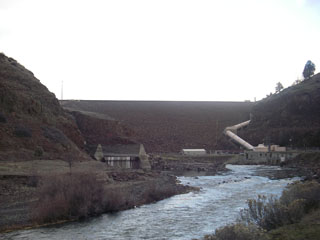
Klamath River Restoration Public Comment Period Open (OR/CA)
A public comment period is now open for the restoration of the Klamath River through November
21st. Secretary of the Interior Ken Salazar announced in late September that the federal
government has completed numerous peer-reviewed scientific and technical studies providing new
and detailed information about the environmental and economic impacts of removing four Klamath
River hydroelectric dams – fulfilling a major condition of the Klamath Hydroelectric
Settlement Agreement (KHSA), which was negotiated among state, local, tribal and water provider
leaders and announced in February 2010 (read
Secretary Salazar press release).
The studies estimate that dam removal would result in the loss of some recreational opportunities
on the Klamath River reservoirs. In addition the loss of peaking flows through Hell's Corner
would impact late summer boating opportunities. Bill Cross published an article in our most
recent American Whitewater journal highlighting the potential new river-based recreational
opportunities that could emerge with restoration of the river including potential new
opportunities for multi-day trips. In his article Bill concluded that removing the dams would be
great but to take full advantage of a restored river and enjoy a quality recreational experience
there are a number of details that need to be addressed in the restoration plan. The time to
weigh in with these specific needs is now as restoration plans are being developed:
o Public Access: Access is vital, especially where whitewater difficulty
changes, so boaters can choose runs suited to their skills and tastes. Paddlers should request
new or improved access at Keno Dam, Highway 66 Bridge, JC Boyle Dam Site, Frain Ranch, Above
Wards Canyon, Below Wards Canyon, Irongate Dam Site.
o Assistance for Outfitters: The river has long supported a vibrant commercial
rafting industry. Dam removal will mean changes but these changes can be positive if basic steps
are taken to address outfitter needs. These include improved access at Frain Ranch, timely
issuance of permits for new runs, and restoration of a more natural flow regime just prior to dam
removal to help outfitters evaluate the run and prepare guides, equipment and logistics for
post-dam conditions. Following dam removal, continued access to flow information is important for
all river runners.
o Restoring the River Channel: In removing the dams, all debris associated with
the man-made structures needs to be removed from the river channel to facilitate safe passage. In
addition, vegetation that has colonized the dewatered Ward’s Canyon needs to be
removed.
o Preserving Open Space: PacifiCorp owns 3800 acres adjoining the reservoirs
Management of these lands will profoundly affect river runners. AW supports permanent protection
of all PacifiCorp lands that includes restoration and revegetation.
o Permanent Protection: Finally, to protect the investment in river
restoration, we support designating the entire Upper Klamath from Keno to Irongate as a National
Wild & Scenic River.
Comments are due on November 21st. We will be completing additional review and analysis prior to
the comment deadline.
For additional information:
Read The EIS
(Recreation is 3.20)
Comments can be submitted at
klamathrestoration.gov
Thomas O'Keefe
3537 NE 87th St.
Seattle, WA 98115
